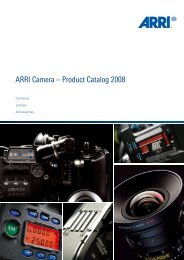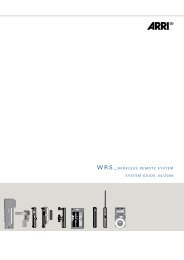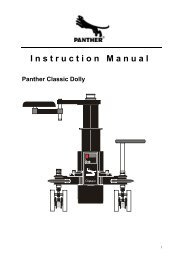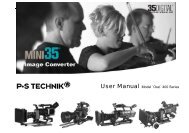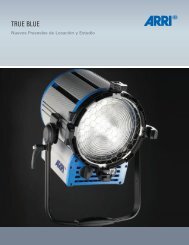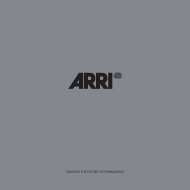ALEXA Studio Electronic and Mirror Shutter
ALEXA Studio Electronic and Mirror Shutter
ALEXA Studio Electronic and Mirror Shutter
Create successful ePaper yourself
Turn your PDF publications into a flip-book with our unique Google optimized e-Paper software.
Motion Portrayal<br />
The use of an electronic top to bottom rolling shutter in contrast to the mirror shutter with its sideways sweeping<br />
motion will result in a subtly different way motion look within the shot. Since <strong>ALEXA</strong> <strong>and</strong> <strong>ALEXA</strong> Plus footage<br />
has been combined very successfully with D-21 <strong>and</strong> film footage in the past, this difference is probably too small<br />
to be noticed by most audiences.<br />
Strobing<br />
Strobing occurs when the individual frames of a movie are not seen as representing a continuous motion. At 24<br />
fps/180º there is a certain amount of motion blur, since the exposure time is so long (1/48th of a second) that<br />
fast movements in the frame result in a blurred image. This actually helps the illusion of continuous motion<br />
between the frames <strong>and</strong> "glues" the frames together. If the shutter angle is reduced, say to 45º, then the<br />
exposure time would be shorter, <strong>and</strong> each image would have less motion blur. While theoretically 24 images<br />
with less blur in them sounds like a good idea, we would start seeing them as 24 individual frames, <strong>and</strong> thus<br />
experience strobing.<br />
A large number of tests between an ARRIFLEX 435 film camera, a D-21 with the mirror shutter on, a D-21 with<br />
the mirror shutter off <strong>and</strong> an <strong>ALEXA</strong> have shown no difference at all in the strobing behavior of an electronic<br />
shutter vs. a mirror shutter.<br />
Strobing <strong>and</strong> Safe Panning Speeds<br />
Strobing can also occur when the "difference" from one frame to the next is too great. With just a minute change<br />
between frames there won't be much strobing; in a static shot of an immobile subject there will be no strobing,<br />
even with a 11.2º shutter. But a shot at 180º might have a lot of strobing if the pan was done too fast, since the<br />
elements in the image changed too much from frame to frame.<br />
Existing safe panning speeds established for film cameras apply as well to all <strong>ALEXA</strong>s with an electronic shutter<br />
<strong>and</strong> to the <strong>ALEXA</strong> <strong>Studio</strong> with its mirror shutter.<br />
<strong>Mirror</strong> <strong>Shutter</strong> Limitations<br />
Photosite read-out <strong>and</strong> subsequent reset take a finite amount of time <strong>and</strong> have to occur during that portion of<br />
the VIEW phase when the sensor is completely covered by the mirror shutter. As the frame rate of the camera is<br />
increased the time available for read-out <strong>and</strong> reset gets shorter <strong>and</strong> shorter. In 4:3 mode at 37 fps (in 16:9 mode<br />
at 47 fps) the available time is too short <strong>and</strong> artifacts could be seen. To avoid this <strong>and</strong> still allow faster frame<br />
rates, the camera will reduce the open mirror shutter angle (which increases the duration of the time the sensor<br />
is covered) to maintain the necessary time for read-out <strong>and</strong> reset.<br />
When changing fps on the <strong>ALEXA</strong> <strong>Studio</strong> with the mirror shutter on, the SHUTTER screen will always pop up<br />
once a new fps is chosen. If the shutter needs to be reduced the camera will suggest a legal shutter angle that<br />
makes calculating exposure differences easy. This shutter angle is most likely below the maximum angle<br />
possible at the given frame rate, but can be manually set to the maximum possible angle. For instance, when<br />
changing from 24 fps/180º to 48 fps in 4:3 mode, the maximum angle possible is 139.2º, but after the FPS<br />
screen the SHUTTER screen will pop up with 135º selected. 135º is 1/2 stop less light than 180º. It is now<br />
possible to simply acknowledge the 135º or to set the shutter to the maximum possible value of 139.2º.<br />
Of course, the appropriate exposure compensation for the reduced shutter angle must be taken into<br />
consideration. In our example at 135º the lens' iris would have to be opened up by 1.5 stops; 1 stop for the<br />
switch in fps <strong>and</strong> 1/2 stop for the change in shutter angle.<br />
The exact frame rates <strong>and</strong> shutter angles are listed in the <strong>ALEXA</strong> <strong>Studio</strong> data sheet, which can be downloaded<br />
from the ARRI website.<br />
Operational Notes<br />
Viewfinder Notes<br />
When the mirror shutter of the <strong>ALEXA</strong> <strong>Studio</strong> is on, it is possible to use either the optical viewfinder OVF-1 or to<br />
replace it with the <strong>Electronic</strong> Viewfinder EVF-1. However, when the mirror shutter is off, only the EVF-1 can be<br />
used, as there is no mirror shutter to reflect light into an optical viewfinder.<br />
While optical viewfinders show no delay between the time an event happens in front of the camera <strong>and</strong> when it<br />
can be seen in the viewfinder, they do not show the image at the exact time when the sensor is exposed. This<br />
can be an issue for events with a duration approximately the same as the exposure time, i.e. a gun's muzzle<br />
<strong>ALEXA</strong> <strong>Studio</strong> <strong>Electronic</strong> <strong>and</strong> <strong>Mirror</strong> <strong>Shutter</strong> White Paper Page 7 of 9



